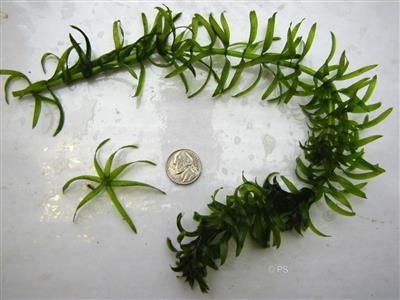Brazilian Elodea

Species at Glance
Brazilian elodea, also known as Brazilian waterweed, is a leafy, submerged aquatic perennial plant. It is widely used as an aquarium plant because of its showy flowers and oxygen generating capabilities.
Species Description
Brazilian elodea can reach lengths of greater than 3 m (10 ft) and survive either rooted or free-floating in up to 6 m (20 ft) of water. The leaves are bright to dark green, blade-shaped, with very fine teeth on the leaf margins that are only visible with magnification. Leaves are densely arranged in whorls of 4-6, although occasionally they can be found in whorls of three. Flowers are large and showy with three white petals, a yellow center, and three green sepals. They emerge above or at the water’s surface on slender stalks projecting from leaf axils near the stem tips.
Native & Introduced Ranges
Native to Brazil and coastal regions of Argentina and Uruguay, Brazilian elodea is found to be invasive throughout the United States and at least 27 other countries. The earliest record in the United States was in 1893 when the plant was collected on Long Island, New York. In Pennsylvania, it can be found in the southeast and northwest regions.
Biology & Spread
In the early 1900’s, Brazilian elodea was promoted as an oxygenator of fresh water and was frequently used in aquaculture. It is also an attractive and robust plant that has been sold around the world as an aquarium plant, so initial introduction of Brazilian elodea was most likely through intentional or unintentional release due to its popularity in the aquarium and water garden trades.
To date, all introductions in the United States appear to be male plants. Because of this, it can only reproduce by plant fragments, which can attach to recreational boats, trailers, and equipment and spread to new water bodies. Once established, Brazilian Elodea can cover 100 acres of water per year.
Habitat
In its native range, Brazilian elodea lives in slow-moving and shallow waters. In its invasive range, it can be found in lakes, ponds, sluggish rivers, and streams. It grows best in enriched, somewhat acidic lakes, and prefers substrates of sand, mud, or stone.
Impacts
Threat to biodiversity
Brazilian elodea grows rapidly, up to 30 cm [11.8 in] in length per day in ideal conditions, and forms dense mats at the water’s surface. These mats crowd out native species, impede aquatic recreational activities such as boating and fishing, degrade water quality, and impact habitat quality for native species of fish.
Economic Costs
Large mats of Brazilian elodea can negatively impact navigation, delivery of irrigation systems, power and hydroelectric generation infrastructure, and can clog water intake pipes. The dense canopies formed can also impede recreational activities such as boating and fishing.
Prevention & Control
Once established in an area, Brazilian elodea can be very difficult and expensive to eradicate. Possible control mechanisms can include physical removal, herbicide use, biological control, and water drawdowns, however mechanical harvesting and hand removal can actually help spread the plant through fragmentation and should be done with caution.
Preventing the introduction and spread of Brazilian elodea is the best way to protect natural habitats from harm. Always remove any visible mud, plants and debris from boats, trailers, and equipment before leaving a water body. Eliminate water from all equipment before transporting. Clean gear and equipment with the hottest water possible (140°F or 60°C is ideal), or salt water, OR let dry thoroughly for five days before entering a new water body.
References:
Walsh, G.C. Magiali Dalto, Y. Mattioli, F.M., Carruthers, R. I., Anderson, L.W. 2013. Biology and ecology of Brazilian elodea (Egeria densa) and its specific herbivore, Hydrellia sp., in Argentina. BioControl. 58: 133-147
Yarrow, M., Marin, V.H., Finlayson, M., Tironi, A., Delgado, L.E., and Fischer, F. 2009. The ecology of Egeria densa Planchon (Liliopsidea: alismatales): A wetland ecosystem engineer. Review Article. Revista Chilena de Historia Natural. 82: 299-313.



